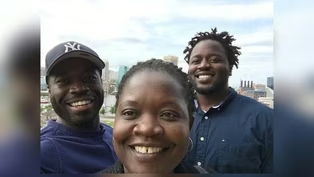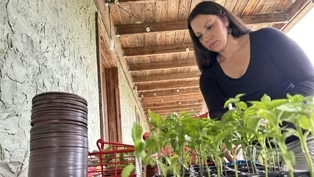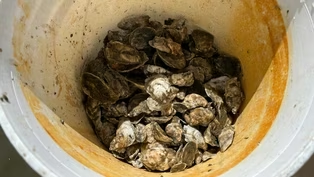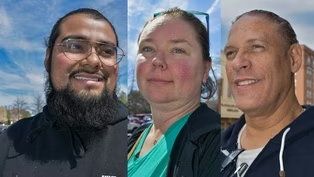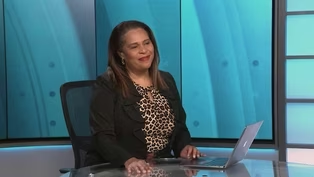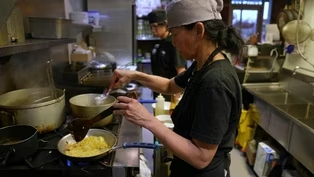VPM News Focal Point
Food and Culture | March 23, 2023
Season 2 Episode 5 | 26m 46sVideo has Closed Captions
Immigrants bring home to Virginia; Protecting Indigenous seeds; famous Virginia oysters
Immigrants from 46 countries bring culture and cuisine to Harrisonburg; Seed Keepers - Protecting Indigenous seeds helps Native Americans reclaim their history and culture. Meet a farmer who says oysters are the mascot for VA’s seafood scene.
Problems playing video? | Closed Captioning Feedback
Problems playing video? | Closed Captioning Feedback
VPM News Focal Point is a local public television program presented by VPM
The Estate of Mrs. Ann Lee Saunders Brown
VPM News Focal Point
Food and Culture | March 23, 2023
Season 2 Episode 5 | 26m 46sVideo has Closed Captions
Immigrants from 46 countries bring culture and cuisine to Harrisonburg; Seed Keepers - Protecting Indigenous seeds helps Native Americans reclaim their history and culture. Meet a farmer who says oysters are the mascot for VA’s seafood scene.
Problems playing video? | Closed Captioning Feedback
How to Watch VPM News Focal Point
VPM News Focal Point is available to stream on pbs.org and the free PBS App, available on iPhone, Apple TV, Android TV, Android smartphones, Amazon Fire TV, Amazon Fire Tablet, Roku, Samsung Smart TV, and Vizio.
Providing Support for PBS.org
Learn Moreabout PBS online sponsorshipANGIE MILES: Food is sustenance, food is health, and food is so much more.
We're taking a trek across our commonwealth, noting how food connects our immigrant population to their original homes.
We learn about Indigenous neighbors protecting the legacy of the foods grown by ancestors, and we see how longstanding traditions of our watermen and women deliver delicacies from the tides to our tables.
You're watching VPM News Focal Point.
Production funding for VPM News Focal Point is provided by The estate of Mrs. Ann Lee Saunders Brown.
And by... ♪ ♪ ANGIE MILES: Welcome to VPM News Focal Point.
I'm Angie Miles.
One of the most basic elements of being human is eating.
Food helps to form us from our earliest moments and it continues throughout our lives to define who we are, where we belong, and how we experience the world.
We intend to pause to consider the cultural connections between identity and food.
For centuries, there have been cultures where food is considered medicine.
That philosophy has gained an increasing amount of ground among medical professionals in America today.
Our Virginia Lens looks in on a pediatric practice where food is a significant part of the treatment plan.
ANGIE MILES: The Biden administration has called for Medicaid health benefits to be used for the purchase of groceries.
A creative solution addressing food scarcity and poor nutrition, and acknowledging the medicinal power of food.
In Fredericksburg, Dr. Nimali Fernando has been working on the same issue with children, promoting food as medicine in her pediatric practice.
NIMALI FERNANDO: A lot of the kids I was seeing were either overweight or obese, and I wanted to really sort of study, what are kids eating?
How can I help?
How can we prevent this?
So that's what I set out to do, starting the Dr. Yum Project, and then also shifting my practice to a private practice where I could share a kitchen, share a garden, and really focus on nutrition as sort of the cornerstone of the practice.
ANGIE MILES: By teaching children and their families how food can alleviate many ailments like attention issues and weight challenges, and improve overall wellness, her practice and the connected nonprofit, known as the Dr. Yum Project, are working to change outcomes for whole communities.
HEIDI DEEUGENIO: The Meal o Matic is a really cool tool that you can use.
You can look in your refrigerator or your pantry and see what's available, and then create a customized recipe out of all those things in your kitchen.
It's a really great way to be able to get kids that don't think they like a lot of foods to be able to control what the meal is with foods that they do like.
ANGIE MILES: According to the founders, data demonstrates already that the effort to promote the curative power of food is paying dividends in healthier communities and improved diets.
ANGIE MILES: The Dr. Yum Project has developed a preschool curriculum that's being used with more than 15,000 children in 29 states.
Dr. Fernando and her team want to make a healthier relationship with food part of a cultural shift for the entire country.
More information on food as medicine is available on the Dr. Yum website.
ANGIE MILES: As we talk with people of Virginia about their relationships with food, we found most have an immediate emotional response.
They shared with us how food connects them with loved ones, with traditions, with community.
LINDSAY VELEZ: My husband's Puerto Rican, and when we had our kids, I made a special effort to make the foods that he's used to, and to pass on his culture to our children.
DAVID TORRES: because certain areas of the world, they eat certain things, and then, say you want Indian, you have a bit of the history when you go to a restaurant, like you'll see what they have around the restaurant, what's normal to them, W. HOWARD MYERS: Growing up, as a kid you lived in the kitchen.
When family and friends came over, you know, there was always a meal.
Your mother or grandmother was in the kitchen preparing a meal, so yeah, bringing folks together, family, church members, coming over for, you know, a Sunday afternoon meal.
Yeah, it is quite important.
It brings people together, because you get to share in the joy of conversation while you're eating and fellowshipping together.
ANGIE MILES: A number of Virginians talked about being culturally adventurous with food and how learning about other people's traditions often begins with sampling those cultural recipes.
Virginia's immigrant population has more than tripled over the past 30 years, topping 1 million people in 2022.
Immigrants represent nearly 13% of the commonwealth's population, bringing their culture and cuisine to our communities.
VPM News special correspondent Dennis Ting shows us how sometimes they can also help transform a city.
(tool clanging) PARWAR SOFY: We have a grilled fish in the tandoor.
It took an hour about it to cook on there, and on charcoal, and you just smell and taste like youre back home.
DENNIS TING: It's the lunch hour rush at Pasha Rest & Cafe, and the heat is on in the kitchen to live up to its reputation.
PARWAR SOFY: You want authentic Middle Eastern food?
You want authentic Kurdish food?
The best cuisine in Virginia?
And that's guaranteed.
DENNIS TING: Parwar Sofy, the owner of Pasha, opened his restaurant in 2020, bringing his family recipes from Kurdistan to what has now become his new home.
PARWAR SOFY: Man, that kebab is still here to this day.
Just like back home.
You grab that meat, it just falls off just like back home.
DENIS TING: Parwar isn't alone.
Within a few miles you can find other restaurant owners and chefs, also offering a wide range of cuisine from their homelands.
But this isn't New York City or the DC area.
Harrisonburg isn't a big city.
In fact, there are only about 54,000 people who live here.
But it is one of the most diverse cities in the state of Virginia, and that diversity is reflected in its food.
EMILY BENDER: Harrisonburg has one public high school and there are over 60 languages that are spoken in that high school.
DENNIS TING: Emily Bender is the Associate Director of Development with Church World Service in Harrisonburg, which helps refugees and asylum seekers settle into their new life in the Shenandoah Valley.
EMILY BENDER: Syrians, Afghans, Ukrainians, Congolese, Sudanese, Ethiopians, Eritreans.
DENNIS TING: That includes helping people find a taste of home.
EMILY BENDER: Okay, we know where the halal place is and we know, you know, where to point people if they're looking for certain foods.
DENNIS TING: Parwar and other restaurant owners can remember how difficult it was finding authentic food when they first moved to Harrisonburg.
PARWAR SOFY: It was hard not having those foods.
VERONICA AVILA: It was a little bit depressing because it was like you were missing out of what you were used to.
DENNIS TING: Just ask Veronica Avila.
VERONICA AVILA: Being Mexican and having that background, I was like, oh this is not Mexican.
DENNIS TING: Veronica grew up in Mexico and California.
Thanks to people like her, it's now becoming less of a problem.
VERONICA AVILA: Over 300 variety of food options here.
It's huge.
Humongous.
DENNIS TING: Veronica opened Tacos El Primo in 2006, serving authentic Mexican cuisine in the very first registered food truck in the Shenandoah Valley.
VERONICA AVILA: It kind of brings us back to our culture, to what our heritage is from families, right?
And it's passed along to our kids.
DENNIS TING: For Marina Muan, cooking is also a family affair.
MARINA MUAN: I always loved cooking 'cause when I was little, mom sells noodles in Malaysia, so that's why I love make noodles or satay.
DENNIS TING: Marina, who hails from Malaysia, started working at BoBoKo, an Indonesian restaurant, in 2016 as a chef, before taking over as the owner in January, hoping to continue sharing her culture with the Harrisonburg community.
MARINA MUAN: It's just learning people's culture and to understand them better.
And you just realize that people just, it's nice to know people from everywhere.
PARWAR SOFY: Everyone wants food, everyone needs a haircut, so you'll succeed in life with these, right?
DENNIS TING: Parwar says he learned to cook from his father, who moved his family from Kurdistan more than two decades ago, seeking a better life in the United States.
PARWAR SOFY: He had his own business back home as well.
He had a restaurant and a hookah lounge, you know, he had everything back home.
But his stuff was to have a better future for us.
DENNIS TING: Parwar says his goal for Pasha is not only to introduce Harrisonburg to his Kurdish community, it's also to offer new Kurdish arrivals a place of refuge and familiarity.
PARWAR SOFY: When they walk in and see the flag right there, they're like, “Oh, wow, you know, you're from Kurdistan.
” And they love that.
And I enjoy, you know, I enjoy helping them out.
You know, whatever I can do to help 'em out.
DENNIS TING: Parwar and other restaurateurs hope their kitchens stay busy and their dining rooms stay packed, and that sharing their food can create a more inclusive and tastier community in Virginia.
For VPM News Focal Point, I'm Dennis Ting.
ANGIE MILES: Harrisonburg now has about 70 international restaurants, grocery stores, and food trucks.
And the list keeps growing.
In September, the city hosts its annual International Food Festival that attracts more than 9,000 people from across the Shenandoah Valley.
ANGIE MILES: VPM News Focal Point is interested in the points of view of Virginians.
To hear more from your Virginia neighbors, and to share your own thoughts and story ideas, find us online at vpm.org/focalpoint.
ANGIE MILES: Virginia's Indigenous Peoples have traditions associated with food that date back millennia.
Before colonization, they lived off the bounty of the land, growing food based on nature's natural rhythms.
European settlement disrupted those cycles, forcing Native Americans from their homelands, impacting their health, economic security, and culture.
Now, a network of Indigenous people across the mid-Atlantic region are working to reconnect with the land and their ancestral foodways.
And they're doing it with seeds.
VPM News producer Adrienne McGibbon introduces us to Indigenous Virginians who are the Seed Keepers.
ADRIENNE MCGIBBON: It's mid-March and not quite warm enough for planting in Virginia's Blue Ridge Mountains.
But for seed keeper, Desirée Shelly Flores, between her three kids, graduate school and her garden, there's never a free moment.
DESIR ÉE SHELLEY FLORES: Gardening is really a year-round practice.
ADRIENNE MCGIBBON: She started growing these tomatoes, peppers, and eggplants back in January.
(water spraying) Desirée is a native of Baltimore, but as her family grew they decided to move to Catawba, a town outside of Roanoke.
DESIR ÉE SHELLEY FLORES In 2017, my husband and I moved here.
A large portion of that was to be closer to my tribal community, which is the Monacan Indian Nation and to be within what we call Yésa sometimes also called Tutelo-Saponi ancestral homelands.
So I wanted to be sort of in that area, be able to introduce my kids to that part of their ancestry.
ADRIENNE MCGIBBON: Desirée's been gardening since she was a kid and even helped start an Indigenous garden at the University of Maryland where she was a student.
DESIR ÉE SHELLEY FLORES: I think it was at that point I realized there's so much I don't know about our seeds and about our history.
So after graduating, I began to get more involved with Indigenous traditional lifeways and foodways.
ADRIENNE MCGIBBON: Eventually Desirée connected with the Alliance of Native Seed Keepers, a network of Indigenous people committed to cultivating ancestral seeds.
Members of the Alliance plant and grow them, then share them to ensure the Indigenous seeds survive.
Alliance members are mainly based in the mid-Atlantic region, but spread up into the Northeast and even into Canada.
DESIR ÉE SHELLEY FLORES: A lot of these seeds were being housed with seed companies, but not within the Indigenous communities.
People will still talk about Tutelo corn 'cause that's what they've called it is Tutelo strawberry corn.
They say, "Well, the people who used to grow this corn are extinct."
And that they're seed keeping it for them in their memory, sort of romanticizing the memory of Indigenous people and that does a lot of harm to our communities.
ADRIENNE MCGIBBON: Victoria Ferguson, a Monacan elder, grew up on the West Virginia side of the Blue Ridge and now lives in Roanoke.
She learned how to keep seeds from her mother.
VICTORIA FERGUSON: Years ago, my mother started putting them in envelopes and just writing the names on the seeds and that's why you'll see some of the envelopes here because it's something that she used to always do.
ADRIENNE MCGIBBON: Victoria has been keeping seeds for decades.
In her collection today, she prizes her batch of Tutelo strawberry corn, which she's been growing for six years.
VICTORIA FERGUSON: I really, really like the color of them and how they look when they're growing.
ADRIENNE MCGIBBON: She says the seeds are so precious that she's never even tasted the corn because once eaten, the seeds are gone.
VICTORIA FERGUSON: And so, I save almost any seed I could possibly save at this point in time.
But my father used to always say, "It's better to have and not need than to need and not have."
ADRIENNE MCGIBBON: Victoria recalls walks in the woods with her father and siblings.
VICTORIA FERGUSON: And as he's walking through, he would identify different plants.
He would tell them the use of it.
He taught them how to mark their trails so they wouldn't get lost and they can get back home.
ADRIENNE MCGIBBON: Following generations of racism, segregation, and land loss endured by native people.
Victoria laments the loss of connection to tribal places, but she still cherishes what her parents taught her about living in harmony with nature and still keeps the traditions alive.
VICTORIA FERGUSON: My father made sure we built these little ridges to put our seeds in and how he stepped off the garden and he had this stick that he used to put a hole in the ground where the corn seeds would grow.
And so, just being involved with that from the time that I was five so I still plant my corn and beans together like I was taught from my early age.
ADRIENNE MCGIBBON: Victoria taught her own children and now teaches students at Virginia Tech the same method she learned as a young girl.
She started an Indigenous garden on campus in 2014.
From one Virginia College campus to another, researchers at William & Mary are using high-tech tools to enhance ancient knowledge and build food sovereignty.
TROY WIIPONGWII: Food sovereignty is the concept that a community would be completely self-sufficient on their own, being able to grow their own food, commodities.
Whether that be livestock, crops, aquatic animals.
Being able to support their community and the growth of their community sustainably.
ADRIENNE MCGIBBON: Troy Wiipongwii is part of a group designing an AI powered computer program for Virginia's tribes.
The program connects ancient and modern agricultural knowledge to predict the best place for crops to grow, how much that location will yield, and the cost of production.
TROY WIIPONGWII: And we're going out into the communities to talk about what types of foods they're currently eating and what do they think are traditional foods and what would they like to be seen grown on tribal lands if they were to engage in a food sovereignty project is getting a conversation going that's incredibly important for this resurgence of Indigenous food.
I see technology as an enhancement of what's happened in the past with the ability to do real-time kind of evaluation to ensure that we can continue to move forward, either in the way that our ancestors have done it or in a way that is set for the modern age.
ADRIENNE MCGIBBON: Just down the road from William & Mary, the focus turns from sustenance to the sacred.
CHRIS CUSTALOW: Tobacco's used in our community in a way it's more ceremonial and seen more as medicinal.
ADRIENNE MCGIBBON: Historian Chris Custalow, who is Cherokee, shares his knowledge about American Indian life in the 18th century at Colonial Williamsburg.
CHRIS CUSTALOW: These are the tobacco seed pods.
Now, you can fit about 50,000 tobacco seeds within one teaspoon.
ADRIENNE MCGIBBON: Chris was faced with a challenge all Seed Keepers deal with.
In order to cultivate the seeds you have to plant them, but there's always the risk that what you plant won't survive.
He started with just 100 tobacco seeds and his efforts to save them have been a success.
CHRIS CUSTALOW: So, I was able to provide tobacco to not only my own community directly, but the larger Native community in Virginia.
ADRIENNE MCGIBBON: Chris is growing the Indigenous tobacco at Colonial Williamsburg to teach visitors about its historical and cultural significance.
CHRIS CUSTALOW: It's typically taboo to purchase something like that.
So you'd want to grow it yourself, harvest it yourself, or be gifted it.
And so, it's just become a responsibility of mine to provide that to the community.
ADRIENNE MCGIBBON: Chris sees these renewed efforts to cultivate seeds as a kind of activism.
CHRIS CUSTALOW: We have had the longest interaction of colonization here in Virginia and so those tribes here in the local area have stood the test of time and have been here on reservations for the longest period of time as well.
And so, being able to provide these seeds and cultivate these seeds is that form of resistance to all the things that we've lost throughout time to colonization.
ADRIENNE MCGIBBON: Victoria and Desirée support all efforts, both technological and natural, to reconnect communities and revive ancestral practices.
DESIR ÉE SHELLEY FLORES: Fight like you live here.
You're going to fight to protect that land and part of that is taking care of it because you want to take care of it for the next generation, for those who come after you.
ANGIE MILES: Troy Wiipongwii and his team at William and Mary's Global Research Institute recently received a $600,000 grant to support their project.
He hopes the research leads to large-scale food sovereignty efforts, but says that technology cannot solve ongoing tribal issues like limited funding and staffing.
Desiree, Victoria, and Chris are now planting their seeds as the weather warms.
ANGIE MILES: Food evokes memory, family history, and tradition.
Soul food is closely tied to Black cultural identity.
Documentarian and activist Byron Hurt's film called "Soul Food Junkies" addresses the comfort and consequences of the ingredients in soul food.
VPM has collaborated with Byron Hurt on some of his previous documentary work, and we welcome him to our program.
Talk a little bit about what prompted you to make the documentary.
BYRON HURT: I was inspired to make the film after my father was diagnosed with pancreatic cancer and that set off my, my journey to learn more about how food impacts people, more specifically, black people and the black community.
I want to take a quick look at a clip from "Soul Food Junkies."
This is when you went down South to a sporting event and experienced tailgating, the soul food way.
Okay, let's take a look.
BYRON HURT: I grabbed a piece of corn hoping they'd be satisfied, but my man right here wasn't happy.
(men bustling) MAN 1: Get that turkey neck.
(men talking) MAN 1: Get that turkey neck, man!
BYRON HURT: I'm good, man.
MAN 1: Hold up, man, hold up, hold up.
You got to have it right here.
Hey, you got to have that.
BYRON HURT: I'm good, I'm good.
MAN 1: Taste it!
BYRON HURT: I'm good.
MAN 1: Taste it!
BYRON HURT: All right, I'll taste it.
MAN 1: Uh-uh!
You got to taste it in front of us.
BYRON HURT: I'm going to taste it right now.
MAN 1: If it ain't right, telling people it ain't right.
BYRON HURT: Yall, I cannot front That turkey neck drenched in pork juice was delicious.
ANGIE MILES: You were kind of pressured by your peers there in the group to sample some food that you don't normally eat.
What does that say about the sense of belonging that comes with certain types of food and certain ways of eating?
BYRON HURT: Soul food can be, you know, what earns you your 'Black card' or has your 'Black card' revoked.
Because of the fact that I changed my eating habits, you know, over the years and no longer ate some of those traditional soul foods that I guess are considered to be a part of our culinary tradition, it just made for a very funny, humorous moment.
ANGIE MILES: A lot of what is considered soul food comes from what people had to eat because they had nothing else.
What is the connection to slavery and poverty in the soul food diet?
BYRON HURT: Many of those foods helped us to survive some really difficult times during the period of enslavement when Black people were not afforded access to the top quality foods that white people had access to.
But many of hold on to some of those traditional foods, even though there's more information that we have today that suggests that eating too much of it can lead to some really serious health consequences.
And so the point of the film is that we can continue to enjoy soul food if we cook it and prepare it in much healthier ways.
ANGIE MILES: You can watch the full interview on our website.
ANGIE MILES: The Lynnhaven variety of oysters is quite famous in Virginia Beach.
The oysters are also widely known nationally and overseas.
Legend has it that they were among Captain John Smith's first meals when he arrived in Virginia in 1607.
Now, Chris Ludford, oyster farmer and owner of Pleasure House Oysters, is harvesting the Lynnhaven delicacy and teaching about its history.
Multimedia reporter Keyris Manzanares brings us the story.
CHRIS LUDFORD: Go ahead and pitch it off to the port.
People come to Virginia Beach and come to Virginia for the Oyster Trail, to experience oysters and oyster roasts, oyster festivals.
They drink wine with the oysters.
There's a whole relationship that oysters have with the food and wine and tourism world, and people come to Virginia for our oysters.
What it means to be an oyster farmer is to craft a oyster here on the Lynnhaven that meets the reputation of the river and do it in a way that's sustainable and profitable but is good for the environment.
The Lynnhaven oyster is special and unique because of the balance.
It's salty, but not too salty.
It's got seaweed notes.
It's got a great flavor.
It's not earthy or metallic like other areas.
It's just a sweet, briny oyster.
It's just perfect.
It's a 300 year legend.
Oysters are often looked at as being the seafood mascot of Virginia, because it's just been here forever.
It's been the food of royalty.
It was the food throughout the 17 and 1800s.
It's bucket time.
They ate oysters, you know, with the first colonists to help them get through the winter when it was very difficult.
So it's been a food from day one.
It's also was a food of ancient civilizations.
So it's a food that's been around a long time, and it's had its ups and downs.
And now we're finding out new things about it, and we're bringing it back.
And it's just an exciting food to be around.
For every day that we harvest and sell the oysters, there's three or four days of work where we don't make a dime.
And that is keeping the oysters from being crowded.
So that's what we did today.
We split the oysters in their containers, which were bags in this case.
So for every bag that we cleaned and divided became two bags.
So that's a big growth, you know?
So they need room to grow.
So that's what we did today, what we call maintenance.
I call it maintenance work.
In the oyster industry, they call it husbandry.
Some of the benefits of oyster farming are that we are letting the wild oysters come back.
So we're using farmed oysters to sell and supply the needs of the consumer, but at the same time, that lets the wild oysters rebound and come back 'cause their numbers are lower.
Another benefit of oyster farming is that we filter the water.
The oysters filter the water.
They eat algae, bacteria, and they make it into a protein that is great to eat.
A lot of people ask me, what ways can you eat an oyster?
What ways can they be consumed?
It's limitless.
You got oyster po' boys, fried oyster, oyster chowder, oyster stew, oysters raw on the half shell, roasted oysters, oysters like they do in New Orleans where they melt butter and cheese and reduce it down, barbecue oysters, you name it.
ANGIE MILES: Whether it's food harvested from Virginia's waters or pulled from Virginia soil, what we eat tells a story about where we've been and where we're going.
Check our website vpm.org/focalpoint for more about oyster farming, Native seed keeping, food as medicine, and the complete interview with Byron Hurt.
You'll also find special Focal Point coverage of Irvo Otieno's death while in police custody.
Thank you for watching.
We'll see you next time.
Production funding for VPM News Focal Point is provided by The estate of Mrs. Ann Lee Saunders Brown.
And by... ♪ ♪
Activists say Marcus Alert System isn’t doing enough
Video has Closed Captions
Clip: S2 Ep5 | 5m 8s | Advocates say the Marcus Alert System isn't protecting people with mental health issues. (5m 8s)
Connecting with ancient traditions through seeds
Video has Closed Captions
Clip: S2 Ep5 | 7m 59s | Native Americans ensure the survival of heirloom seeds that connect them with the past. (7m 59s)
Video has Closed Captions
Clip: S2 Ep5 | 3m | Lynnhaven oysters are known for their size and saltiness. (3m)
People of Virginia | Food and Culture
Video has Closed Captions
Clip: S2 Ep5 | 1m | We talked with people of Virginia about food, we found most have an emotional response. (1m)
Soul food is closely tied to Black cultural identity
Video has Closed Captions
Clip: S2 Ep5 | 8m 21s | Byron Hurt explores Soul Food and its complicated connections to the Black community. (8m 21s)
Taste of Home: Immigrant-owned restaurants in Harrisonburg
Video has Closed Captions
Clip: S2 Ep5 | 4m 14s | Harrisonburg restaurant owners from Kurdistan, Mexico and Malaysia share their stories. (4m 14s)
This doctor says food is, indeed, medicine
Video has Closed Captions
Clip: S2 Ep5 | 1m 39s | For centuries, there have been cultures that treat diet as medicinal. (1m 39s)
Providing Support for PBS.org
Learn Moreabout PBS online sponsorship
- News and Public Affairs

Top journalists deliver compelling original analysis of the hour's headlines.

- News and Public Affairs

FRONTLINE is investigative journalism that questions, explains and changes our world.












Support for PBS provided by:
VPM News Focal Point is a local public television program presented by VPM
The Estate of Mrs. Ann Lee Saunders Brown
